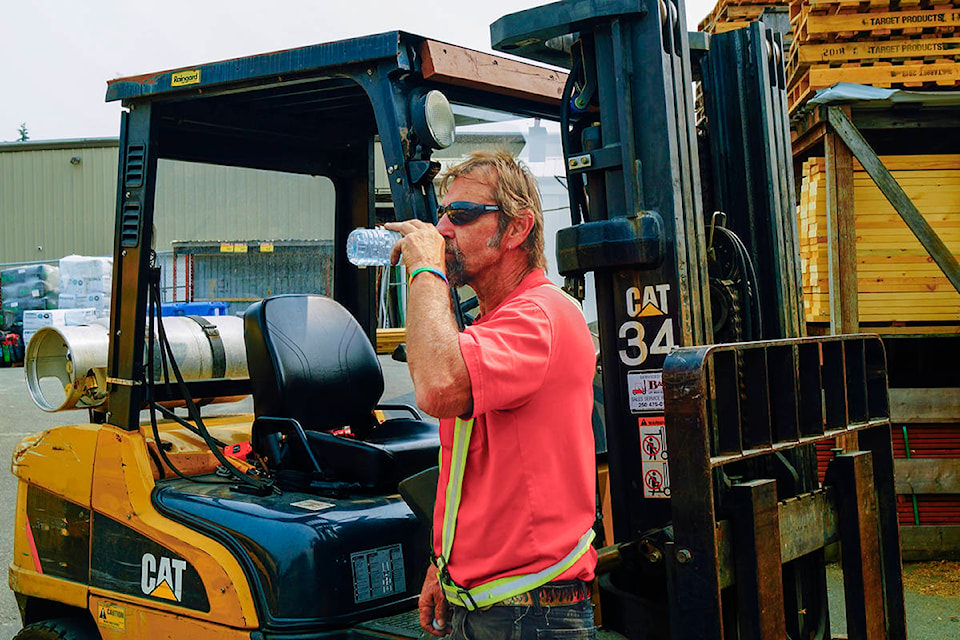Rick Stiebel - Sooke News Mirror
Health risks arising from heat and smoke are more of a threat for people engaged in hardcore physical labour, says an expert in the field with WorkSafe BC.
“It’s important for people to realize that their bodies maintain a natural temperature of 36 to 38 degrees and when doing hard physical labour in the heat, that temperature rises and taxes the body,” explained Patrick Davie, manager of prevention field services for WorkSafe BC.
Signs of heat stress include excessive sweating, nausea and dizziness.
“One (bad) sign is when you stop sweating,” Davie said. “If left untreated, it can lead to loss of consciousness and even death.”
People that work in construction, logging, farming and traffic control are at increased risk to heat stroke, Davie said.
There were 209 accepted claims for heat stress between 2008 and 2017, with 30 of those in 2017 alone, Davie noted. “Last year we had a high number of heat stress claims from occupations you wouldn’t normally consider such as firefighters, welders and truck drivers.”
Employers should have a mitigation plan to reduce the risk if workers are exposed to heat stress.
“That should include educational training for supervisors and workers to recognize the symptoms of heat stress to stop it before it gets too far,” Davie said.
Scheduling the hardest tasks before 11 a.m. or after 3 p.m. and modifying facilities to include shade, fans or air movement, and rotating workers or adding workers to reduce exposure is important, he stressed.
Workers should drink plenty of water, a glass every 20 minutes during extreme heat. Wearing light-coloured clothing such as cotton is also recommended, as well as taking breaks in cool, well-ventilated areas.
Workers should also be aware of personal risk factors caused by factors such as prescribed medications, skin disorders or pre-existing medical conditions, Davie added. “Most importantly, check signs and symptoms for yourself and your co-workers.”
Davie said another safety factor to consider this year is exposure to smoke caused by forest fires.
“There are particulates in the area of the South Island that could be a complex mixture of gasses that include carbon monoxide and carbon dioxide,” said Davie, who is also manager of interest for wildfires for WorkSafe BC.
The common symptoms of smoke exposure include eye, nose and throat irritation, as well as headaches. When exposure is limited to short periods, the symptoms generally go away when the smoke clears.
People with pre-existing conditions such as asthma may experience more severe symptoms such as coughing, sneezing and tightness in the chest.
There were nine WorkSafe BC claims in 2017 related to lost time due to exposure to smoke from wildfires, with none of those resulting in fatalities.
“The primary approach is to reduce contact with smoke,” he said. “Can the work be rescheduled or relocated to areas of less smoke? Heavy exertion can increase air intake by as much as 20 times, which is much more concerning when there’s smoke in the air. Closing windows and doors in a building may not be enough. You may have to look at changing or upgrading the HVAC filters in your system, or consider using a portable air cleaner in the work area.”
Driving in smoky areas also poses risks. Vents and windows should be closed, and air conditioning set on re-circulation mode. Windows should be opened in good air areas as well.
“You have to treat smoke like any workplace hazard and pay attention to air quality alerts,” Davie noted. “Plan activities to minimize exposure.”
There’s more information and videos on heat stress available at worksafebc.ca. Wildfire smoke is covered as well under FAQs and what you can and can’t do, Davie said.
Island Health also has information at the following links:
https://www.islandhealth.ca/health-alerts/health-alerts/wildfires
https://www.islandhealth.ca/news/news-releases/beat-heat-temperatures-rise-across-island-
https://www.islandhealth.ca/sites/default/files/2018-08/smoky-skies-bulletin-august-10-2018.pdf
